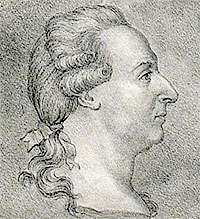Johan Wilcke

Johan Carl Wilcke (6 September 1732 – 18 April 1796) was a Swedish physicist.
Wilcke was born in Wismar, son of a clergyman who in 1739 was appointed second pastor of the German Church in Stockholm. He went to the German school in Stockholm and enrolled at the University of Uppsala in 1749. He spent the years from 1751 travelling abroad and received the magister degree from the University of Rostock in 1757,[1] after having published the dissertation De electricitatibus contrariis. In 1759 he became the first "Thamian lecturer" of experimental physics at the Royal Swedish Academy of Sciences, a position created through a donation from the wealthy merchant Sebastian Tham, and a member of the academy. He became a titular professor in 1770, and permanent secretary of the Academy of Sciences in 1784. He died in Stockholm in 1796.
His two areas of significant research were electricity and caloric theory. In 1762 he invented an electrostatic generator that was a first version of the electrophorus, a device named and popularized in 1775 by Alessandro Volta.[2][3] In 1772 he calculated the latent heat of ice. In 1789 he was elected a Fellow of the Royal Society [4]
Notes
- ↑ See entry of Johan Carl Wilcke in Rostock Matrikelportal
- ↑ Pancaldi, Giuliano (2003). Volta, Science and Culture in the Age of Enlightenment. Princeton Univ. Press., p.73
- ↑ For information about Wilcke's research on the electrophorus (or "dissectible condenser"), see:
- Joh. Carl Wilcke (1762) "Ytterligare rön och försök om contraira electriciteterne vid laddningen och därtil hörande delar" (Additional findings and experiments on the opposing electric charges [that are created] during charging, and parts related thereto) Kongliga Svenska Vetenskaps Academiens Handlingar (Proceedings of the Royal Swedish Science Academy), vol. 23 , pages 206-229, 245-266. Reprinted in German as: Joh. Carl Wilcke (1765) "Fernere Untersuchung von den entgegengesetzten Elecktricitäten bei der Ladung und den dazu gehörenden Theilen" (Further investigation of the opposing electric charges [that are created] during charging and the parts belonging thereto), Der Königliche schwedischen Akademie der Wissenschaften, Abhandlungen aus der Naturlehre, … , vol. 24, pages 213-235, 253-274.
- J.L. Heilbron, Electricity in the 17th and 18th centuries: A study of early modern physics (Berkeley, California: University of California Press, 1979), pages 418 - 419.
- ↑ "Library and Archive catalogue". Retrieved 2012-02-26.
References
- Svenskt biografiskt handlexikon, vol 2, p. 732 (Swedish)
- Encyclopedia.com: Wilcke, Johan Carl
External links
- Johan Carl Wilcke in Rostock Matrikelportal